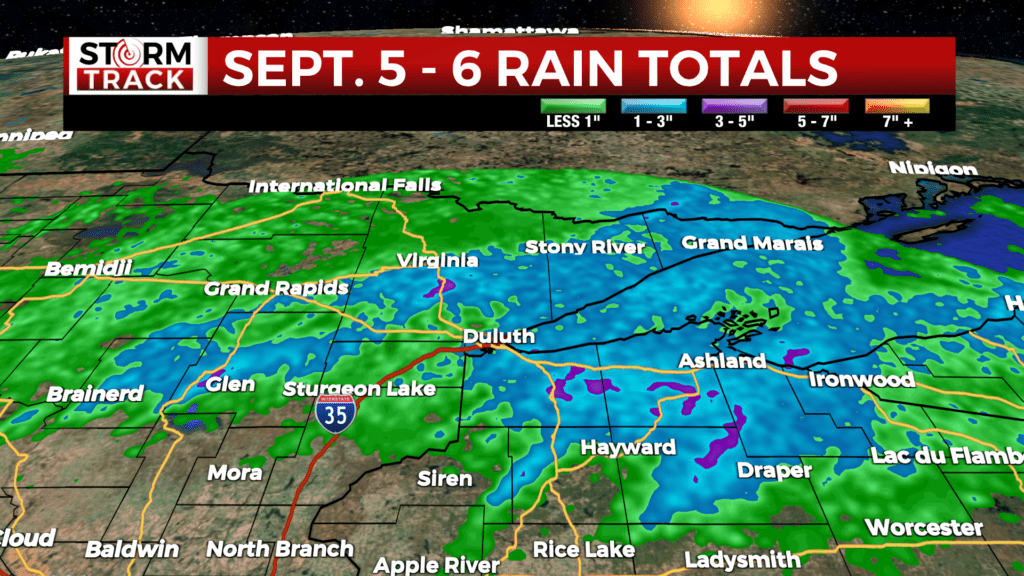Drought worsens for much of the Northland
The latest report from the U.S. Drought Monitor expands areas of moderate, severe, extreme, and exceptional drought in the Northland. The report doesn’t account for rain from Tuesday to Wednesday, which brought 1-3″ to many.
The USDM is a joint effort by National Drought Mitigation Center at the University of Nebraska-Lincoln, the National Oceanic and Atmospheric Administration and the U.S. Department of Agriculture. It is updated on Thursday mornings with data from observations made at 7 a.m. CST on Tuesdays.
Drought intensity is measured in increments from D0 to D4:
- D0 = Abnormally Dry
- D1 = Moderate Drought
- D2 = Severe Drought
- D3 = Extreme Drought
- D4 = Exceptional Drought
Thursday’s report extended moderate drought (D1) across far northern Minnesota with a small area of Cook County as the only part of the Northland staying out of drought classification.
Severe drought (D2) now includes the majority of the Iron Range, Silver Bay, and everywhere south of there.
Extreme drought (D3) has become widespread for Cass, Crow Wing, Aitkin, Carlton, North Pine, South St. Louis, Douglas, Bayfield, and Washburn Co.
The area of exceptional drought (D4) that has been found along the South Shore of Douglas and Bayfield Co. the last several weeks persists. There’s a new area of exceptional drought over a target of Carlton, East Aitkin, and North Pine Co.
Taking a look at Minnesota statewide, more than half the state is in severe, extreme, or exceptional drought. The rest of the state is in moderate drought or abnormally dry conditions.
The breakdown by category is as follows:
- 15% of Minnesota is experiencing abnormally dry conditions.
- 30% of the state is in moderate drought.
- 39% of Minnesota is in severe drought.
- 15% of the state is in extreme drought.
- 1% of Minnesota is in exceptional drought.
According to the Minnesota DNR, two watersheds, the Upper Mississippi-Maquoketa-Plum and Upper Mississippi-Iowa-Skunk-Wapsipinicon, are now in the Drought Restrictive Phase, per the criteria established in Minnesota’s Statewide Drought Plan. This is the first time since 2021 that any watersheds in Minnesota have been in this restrictive phase, which requires public water suppliers to implement significant water conservation measures to reduce consumption.
Over the past seven weeks, the DNR has also suspended 107 surface water appropriation permits for nondomestic use across the state in response to the expanding drought conditions.
“With nearly the entire state experiencing some level of drought it is important for all Minnesotans to take measures to reduce water use,” said DNR Commissioner Sarah Strommen, “The DNR is closely monitoring the levels of our surface waters and aquifers and will take additional restrictive actions if necessary to protect public water supplies.”
Wisconsin is also experiencing worsening conditions statewide with only 3% of the state not experiencing any drought.
The breakdown by category is as follows:
- 12% of Wisconsin is experiencing abnormally dry conditions.
- 26% of the state is in moderate drought.
- 34% of Wisconsin is in severe drought.
- 22% of the state is in extreme drought.
- 3% of Minnesota is in exceptional drought.
The next report may undo some of these deteriorating conditions for the Northland based on Tuesday and Wednesday’s rain.

There isn’t much for additional accumulating rain in the forecast, but some showers are possible this weekend into the start of next week.